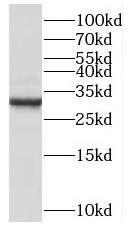产品
C1QBP antibody
| 别称: | Complement component 1 Q subcomponent-binding protein antibody, mitochondrial|ASF/SF2-associated protein p32|Glycoprotein gC1qBP (C1qBP)|Hyaluronan-binding protein 1|Mitochondrial matrix protein p32|gC1q-R protein|p33 (SF2AP32)|C1QBP|GC1QBP|HABP1|SF2P32 antibody | ||
| 货号: | FNab01073 | 反应性: | Human, Mouse |
| 宿主: | Rabbit | 验证实验: | ELISA, WB, IHC, IF |
| 克隆性: | polyclonal | 亚型: | IgG |
| 规格 | 价格 |
|---|---|
| 100μg | RMB ¥1750 |
| 50μg | RMB ¥1050 |
- 产品介绍
- 实验结果
- 实验条件
- 常见问题
- 产品名称
- C1QBP antibody
- 货号
- FNab01073
- 规格
- 100μg
- 状态
- liquid
- 纯化方法
- Immunogen affinity purified
- 纯度
- ≥95% as determined by SDS-PAGE
- 克隆性
- polyclonal
- 亚型
- IgG
- 存储
- PBS with 0.02% sodium azide and 50% glycerol pH 7.3, -20℃ for 12 months(Avoid repeated freeze / thaw cycles.)
- 免疫原
- complement component 1, q subcomponent binding protein
- 别称
- Complement component 1 Q subcomponent-binding protein antibody, mitochondrial|ASF/SF2-associated protein p32|Glycoprotein gC1qBP (C1qBP)|Hyaluronan-binding protein 1|Mitochondrial matrix protein p32|gC1q-R protein|p33 (SF2AP32)|C1QBP|GC1QBP|HABP1|SF2P32 antibody
- UniProt ID
- Q07021
- 分子量
- 32 kDa
- 验证实验
- ELISA, WB, IHC, IF
- 建议稀释比例
- WB: 1:500-1:2000; IHC: 1:20-1:200; IF: 1:20-1:200
 K-562 cells were subjected to SDS PAGE followed by western blot with FNab01073(C1QBP Antibody) at dilution of 1:1000
K-562 cells were subjected to SDS PAGE followed by western blot with FNab01073(C1QBP Antibody) at dilution of 1:1000
 Immunohistochemistry of paraffin-embedded human tonsillitis slide using FNab01073(C1QBP Antibody) at dilution of 1:50
Immunohistochemistry of paraffin-embedded human tonsillitis slide using FNab01073(C1QBP Antibody) at dilution of 1:50
- 背景介绍
- Is believed to be a multifunctional and multicompartmental protein involved in inflammation and infection processes, ribosome biogenesis, regulation of apoptosis, transcriptional regulation and pre-mRNA splicing. At the cell surface is thought to act as an endothelial receptor for plasma proteins of the complement and kallikrein-kinin cascades. Putative receptor for C1q; specifically binds to the globular "heads" of C1q thus inhibiting C1; may perform the receptor function through a complex with C1qR/CD93. In complex with cytokeratin-1/KRT1 is a high affinity receptor for kininogen-1/HMWK. Can also bind other plasma proteins, such as coagulation factor XII leading to its autoactivation. May function to bind initially fluid kininogen-1 to the cell membrane. The secreted form may enhance both extrinsic and intrinsic coagulation pathways. It is postulated that the cell surface form requires docking with transmembrane proteins for downstream signaling which might be specific for a cell-type or response. By acting as C1q receptor is involved in chemotaxis of immature dendritic cells and neutrophils and is proposed to signal through CD209/DC-SIGN on immature dendritic cells, through integrin alpha-4/beta-1 during trophoblast invasion of the decidua, and through integrin beta-1 during endothelial cell adhesion and spreading. Signaling involved in inhibition of innate immune response is implicating the PI3K-AKT/PKB pathway. In mitochondrial translation may be involved in formation of functional 55S mitoribosomes; the function seems to involve its RNA-binding activity. May be involved in the nucleolar ribosome maturation process; the function may involve the exchange of FBL for RRP1 in the association with pre-ribosome particles. Involved in regulation of RNA splicing by inhibiting the RNA-binding capacity of SRSF1 and its phosphorylation. Is required for the nuclear translocation of splicing factor U2AF1L4. Involved in regulation of CDKN2A-and HRK-mediated apoptosis. Stabilizes mitochondrial CDKN2A isoform smARF. May be involved in regulation of FOXC1 transcriptional activity and NFY/CCAAT-binding factor complex-mediated transcription. In infection processes acts as an attachment site for microbial proteins, including Listeria monocytogenes internalin B and Staphylococcus aureus protein A. May play a role in antibacterial defense as it can bind to cell surface hyaluronan and inhibit Streptococcus pneumoniae hyaluronate lyase. Involved in replication of Rubella virus. May be involved in modulation of the immune response; ligation by HCV core protein is resulting in suppresion of interleukin-12 production in monocyte-derived dendritic cells. Involved in regulation of antiviral response by inhibiting DDX58-and IFIH1-mediated signaling pathways probably involving its association with MAVS after viral infection. Involved in HIV-1 replication, presumably by contributing to splicing of viral RNA.
抗体可以回收利用几次?
一般抗体不推荐回收利用,抗体使用之后缓冲体系已经发生改变,不同客户在回收抗体的保存条件上也会有差异,所以抗体回收使用效果无法保证。
FineTest公司也做过一批抗体回收验证测试,测试结果显示不同抗体可回收次数不同,一般效价越高的抗体,可重复使用的次数越多,客户可根据实验情况来确定。
注:我们将孵育完毕后剩余的抗体回收到离心管中置于4℃保存,效价高的抗体可至少保存1周,重复利用3次左右。
FineTest公司抗体buffer成分是什么?
FineTest抗体成分一般是PBS含proclin300或sodium azide、BSA、50%甘油;也有一些是PBS含proclin300或sodium azide,50%甘油。防腐剂proclin300或sodium azide是常用的防腐剂,广泛应用于实验室和工业中。
FineTest公司抗体的保存温度和时间?
大部分抗体是放在-20℃保存,直标流式抗体需要放在2-8℃保存,质保期一年,质保期内抗体出现售后,可进行退货或换货。
一般抗体超过一年质保期仍旧可以使用,我们可以提供技术支持服务。
FineTest公司抗体使用需要稀释吗?用什么溶液稀释?
除了直标流式抗体为即用型,不用稀释。其他抗体一般为浓缩型,使用时需要按照说明书建议稀释比例稀释。
不同实验使用的稀释液不同,用PBST, TBST, 抗体封闭液等常用抗体稀释液均可。
免疫组化实验抗体的修复方式?
常用修复液:Tris-EDTA缓冲液(Tris-EDTA Buffer, pH 9.0);柠檬酸盐缓冲液(Citrate Buffer, pH 6.0)
热修复:
方法1:沸水浴修复,将盛有修复液和玻片的烧杯置于沸水浴环境,保持外部沸腾状态15min,自然冷却至室温;
方法2:微波修复,将盛有修复液和玻片的烧杯置于微波炉中,高火5min,停火3min,中火5min,自然冷却至室温。
如何选择二抗?
(1)二抗是和一抗反应的,所以二抗必须是抗一抗宿主物种,比如一抗来源于兔,对应二抗则选择抗兔二抗,比如羊抗兔或驴抗兔。
(2)根据实验类型选择二抗偶联物,比如做ELISA, 蛋白质印迹,IHC实验,常用酶联二抗,如HRP,AP等标记。而免疫荧光实验,流式细胞术实验中,则用荧光蛋白或染料标记,比如FITC,Cy3等。














